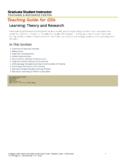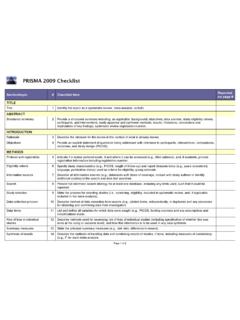Transcription of GUIDELINES ON PHYSICAL ACTIVITY, SEDENTARY …
1 GUIDELINES ON PHYSICAL activity , SEDENTARY BEHAVIOUR AND SLEEPFOR CHILDREN UNDER 5 YEARS OF AGEE arly childhood is a period of rapid PHYSICAL and cognitive development and a time during which a child s habits are formed and family lifestyle habits are open to changes and adaptations. The WHO GUIDELINES on PHYSICAL activity , SEDENTARY behaviour and sleep for children under 5 years of age provide recommendations on the amount of time in a 24-hour day that young children, under 5 years of age, should spend being physically active or sleeping for their health and wellbeing, and the maximum recommended time these children should spend on screen-based SEDENTARY activities or time restrained. They were developed using the best available evidence, expert consensus and consideration of values and preferences, acceptability, feasibility, equity and resource implications .
2 To meet daily PHYSICAL activity time recommendations, particularly in children, the pattern of overall activity across a 24-hour period needs to be considered, since every day is made up of sleep time, SEDENTARY time and light-, moderate- or vigorous-intensity PHYSICAL activity . Young children should have opportunities to participate in a range of developmentally-appropriate, safe, enjoyable play-based PHYSICAL activities. The quality of SEDENTARY time matters and interactive non-screen-based activities, such as reading, storytelling, singing and puzzles are important for social and cognitive development as well as recreation and relaxation. Regular sleep and wake-up times can help to ensure adequate, good quality SCREEN TIMEGOOD QUALITY SLEEPPHYSICAL ACTIVITYRECOMMENDATIONS FOR 24-HOUR PHYSICAL activity , SEDENTARY BEHAVIOUR AND SLEEP FOR CHILDREN UNDER 5 YEARS OF AGE24In a 24-hour day,30 minutesat least0 minute(4 11 months of age)12 16 hours(0 3 months of age)14 17 hoursThese GUIDELINES are for all healthy children under 5 years of age, irrespective of gender, cultural background or socio-economic status of families and are relevant for children of all abilities; caregivers of children with a disability or those with a medical condition, however, may seek additional guidance from a health (less than 1 year) should:Be physically active several times a day in a variety of ways, particularly through interactive floor-based play; more is better.
3 For those not yet mobile, this includes at least 30 minutes in prone position (tummy time) spread throughout the day while be restrained for more than 1 hour at a time ( prams/strollers, high chairs, or strapped on a caregiver s back). Screen time is not recommended. When SEDENTARY , engaging in reading and storytelling with a caregiver is 14 17 hours (0 3 months of age) or 12 16 hours (4 11 months of age) of good quality sleep, including naps. For the greatest health benefits, infants, and young children should meet all the recommendations for PHYSICAL activity , SEDENTARY behaviour and sleep in a 24-hour restrained or SEDENTARY screen time with more moderate- to vigorous-intensity PHYSICAL activity , while preserving sufficient sleep, can provide additional health SCREEN TIMESEDENTARY SCREEN TIMEGOOD QUALITY SLEEPGOOD QUALITY SLEEPPHYSICAL ACTIVITYPHYSICAL activity children 3 4 years of age should:Spend at least 180 minutes in a variety of types of PHYSICAL activities at any intensity, of which at least 60 minutes is moderate- to vigorous-intensity PHYSICAL activity , spread throughout the day.
4 More is 10 13 hours of good quality sleep, which may include a nap, with regular sleep and wake-up 1 2 years of age should:Spend at least 180 minutes in a variety of types of PHYSICAL activities at any intensity, including moderate- to vigorous-intensity PHYSICAL activity , spread throughout the day; more is 11 14 hours of good quality sleep, including naps, with regular sleep and wake-up 13 hours180 minutesat leastof which at leastmoderate to vigorous60 minutes180 minutesat least11 14 hours0 minute60 minutesno more than(1 year of age)(2 years of age)60 minutesno more thanNot be restrained for more than 1 hour at a time ( prams/strollers) or sit for extended periods of time. SEDENTARY screen time should be no more than 1 hour; less is better. When SEDENTARY , engaging in reading and storytelling with a caregiver is be restrained for more than 1 hour at a time ( prams/strollers, high chairs, or strapped on a caregiver s back) or sit for extended periods of time.
5 For 1-year-olds, SEDENTARY screen time (such as watching TV or videos, playing computer games) is not recommended. For those aged 2 years, SEDENTARY screen time should be no more than 1 hour; less is better. When SEDENTARY , engaging in reading and storytelling with a caregiver is the recommendations in these GUIDELINES during the first 5 years of life is associated with better motor and cognitive development, psychosocial (emotional regulation) and cardiometabolic health, bone and skeletal health and reduced risk of injuries. Time spent restrained should be limited. Over the course of a day, a combination of more PHYSICAL activity , less SEDENTARY screen time and longer sleep duration results in the greatest GUIDELINES are intended to assist all countries in the development of national plans and programmes aimed at increasing levels of PHYSICAL activity , reducing SEDENTARY time and improving time spent sleeping in young development of these new WHO GUIDELINES was a recommendation of both the Commission on Ending Childhood Obesity1 and the Global Action Plan on PHYSICAL activity 2018 on PHYSICAL activity , SEDENTARY behaviour and sleep for children under 5 years of World Health Organization 2019.
6 Some rights reserved. This work is available under the CC BY-NC-SA IGO licence.













